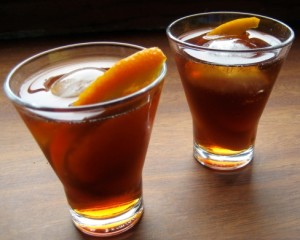 I am back from an absolutely incredible vacation during which I spent two weeks tasting my way through parts of Italy, Spain, and Portugal. I spent the first week exploring the Tuscan region of Italy with my boyfriend and his wonderful family and the second week wandering the streets of Barcelona, Madrid, Seville, and Lisbon with Andrew Sarubbi, an amazing friend of mine and the beloved manager and cocktail expert of McKinney and Doyle. In Italy, we focused a lot on food and wine (naturally), and in Spain, Andrew and I focused on food and cocktails (and wine, but mostly food and cocktails). Now, I love all three of those things (food, wine, and cocktails) but most of my knowledge in the realm of food. Andrew however, thrives in the wine and liquor department so I was happy to follow his lead on our quests. We had a lot of unique concoctions and I can’t say that there was anything that I didn’t like but I was really surprised at one thing in particular that I loved: sweet vermouth.
I am back from an absolutely incredible vacation during which I spent two weeks tasting my way through parts of Italy, Spain, and Portugal. I spent the first week exploring the Tuscan region of Italy with my boyfriend and his wonderful family and the second week wandering the streets of Barcelona, Madrid, Seville, and Lisbon with Andrew Sarubbi, an amazing friend of mine and the beloved manager and cocktail expert of McKinney and Doyle. In Italy, we focused a lot on food and wine (naturally), and in Spain, Andrew and I focused on food and cocktails (and wine, but mostly food and cocktails). Now, I love all three of those things (food, wine, and cocktails) but most of my knowledge in the realm of food. Andrew however, thrives in the wine and liquor department so I was happy to follow his lead on our quests. We had a lot of unique concoctions and I can’t say that there was anything that I didn’t like but I was really surprised at one thing in particular that I loved: sweet vermouth.
I learned a little about vermouth as a bartender, but my knowledge was pretty limited. Dry vermouth for a martini and sweet in a Manhattan. But after listening to what Andrew had to say, tasting some house made vermouths in various bars in Spain, and reading up on the subject when I got home, I have a whole new respect for this mysterious fortified wine. It’s actually a really interesting subject to read about, and Vermouth 101 does a great job of helping you to really understand the ins and outs, but I’ll break it down a little bit here today.
First off, all vermouths are part of the aperitif wine category. Aperitifs have a bittersweet quality, which help to kindle the appetite because it stimulates the production of gastric juices in the body. Vermouth, all types of vermouth, is also a fortified wine, which just means that a spirit has been added to increase the alcohol percentage. But the alcohol content isn’t anything crazy. It tends to be a bit higher than a regular wine, but still less than most other spirits. In terms of alcohol content, vermouths are comparable to Ports or Sherries.
Vermouth entered the commercial market during the 18th century in Italy. Originally it was a relatively sweet, dark red in color, herbal tasting beverage. This red vermouth blew up in the US in the 1880s and has since become associated with the Manhattan. However in Europe, Italian/red/sweet vermouth is enjoyed alone served over a bit of ice (this is how I tried and loved it).
Shortly after red vermouth was introduced to the masses, a drier version became available. This is the vermouth we know to be used in martinis but it’s also a very popular cooking ingredient. White or Blanc vermouth has yet to see the same popularity in the US, but it’s been growing as the cocktail industry becomes more studied and practiced.
I wanted to take today to just go over the very basics of vermouth. There really is SO much to learn about it including the different types, the variety in flavors dependent on the region it’s created, the method to making it, uses behind the bar and in the kitchen, and the entire history behind it. I encourage those interested to read up on it or better yet, talk to your favorite bartender about it. For those of you local to McKinney and Doyle, Andrew is a great teacher and would be happy to dive into a lesson with you.
Rebecca McKinney
I wanted to create this blog for a few reasons. First and foremost, to share tips, tricks, and knowledge about the food and beverage industry in general but also to help people see a different side of the restaurant world. Every restaurant has a totally unique culture and world within it. I want to help open people’s eyes to more than how fast the service is or how easy or hard it is to secure a reservation.
So, thanks for stopping by! I welcome your ideas, input, and feedback and hope you enjoy!
Eat well & travel often,
Becky McKinney
Latest posts by Rebecca McKinney (see all)
- Why Food Makes the Best Gift for a New Mom - April 12, 2023
- 5 Ingredients to Cook With This Spring - March 15, 2023
- 10 Reasons to Dine Out on Valentine’s Day - February 2, 2023



Leave a Reply